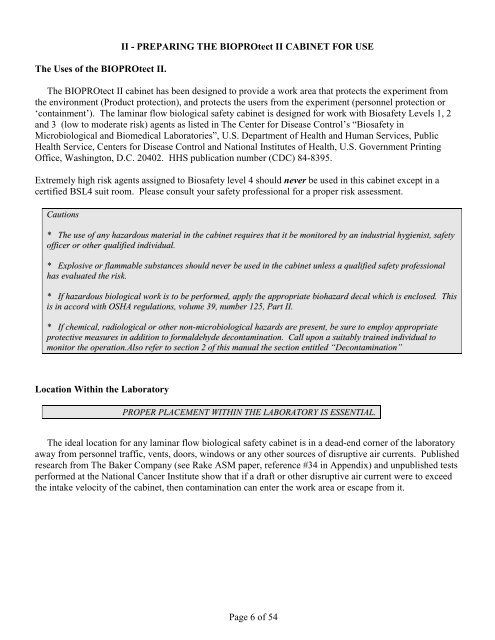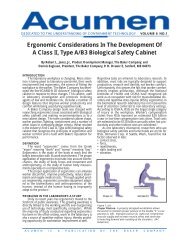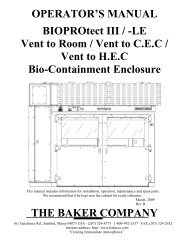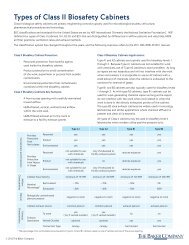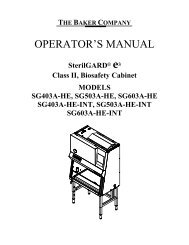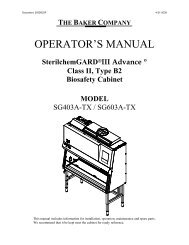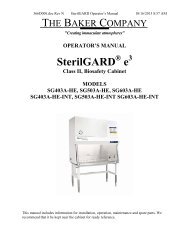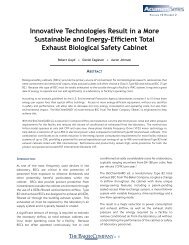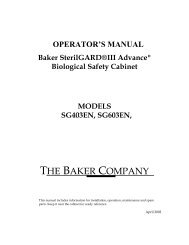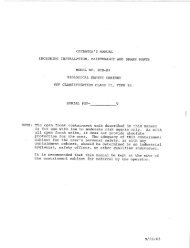OPERATOR'S MANUAL BIOPROtect II Vent to ... - Baker Company
OPERATOR'S MANUAL BIOPROtect II Vent to ... - Baker Company
OPERATOR'S MANUAL BIOPROtect II Vent to ... - Baker Company
Create successful ePaper yourself
Turn your PDF publications into a flip-book with our unique Google optimized e-Paper software.
The Uses of the <strong>BIOPROtect</strong> <strong>II</strong>.<strong>II</strong> - PREPARING THE <strong>BIOPROtect</strong> <strong>II</strong> CABINET FOR USEThe <strong>BIOPROtect</strong> <strong>II</strong> cabinet has been designed <strong>to</strong> provide a work area that protects the experiment fromthe environment (Product protection), and protects the users from the experiment (personnel protection or‘containment’). The laminar flow biological safety cabinet is designed for work with Biosafety Levels 1, 2and 3 (low <strong>to</strong> moderate risk) agents as listed in The Center for Disease Control’s “Biosafety inMicrobiological and Biomedical Labora<strong>to</strong>ries”, U.S. Department of Health and Human Services, PublicHealth Service, Centers for Disease Control and National Institutes of Health, U.S. Government PrintingOffice, Washing<strong>to</strong>n, D.C. 20402. HHS publication number (CDC) 84-8395.Extremely high risk agents assigned <strong>to</strong> Biosafety level 4 should never be used in this cabinet except in acertified BSL4 suit room. Please consult your safety professional for a proper risk assessment.Cautions* The use of any hazardous material in the cabinet requires that it be moni<strong>to</strong>red by an industrial hygienist, safetyofficer or other qualified individual.* Explosive or flammable substances should never be used in the cabinet unless a qualified safety professionalhas evaluated the risk.* If hazardous biological work is <strong>to</strong> be performed, apply the appropriate biohazard decal which is enclosed. Thisis in accord with OSHA regulations, volume 39, number 125, Part <strong>II</strong>.* If chemical, radiological or other non-microbiological hazards are present, be sure <strong>to</strong> employ appropriateprotective measures in addition <strong>to</strong> formaldehyde decontamination. Call upon a suitably trained individual <strong>to</strong>moni<strong>to</strong>r the operation.Also refer <strong>to</strong> section 2 of this manual the section entitled “Decontamination”Location Within the Labora<strong>to</strong>ryPROPER PLACEMENT WITHIN THE LABORATORY IS ESSENTIAL.The ideal location for any laminar flow biological safety cabinet is in a dead-end corner of the labora<strong>to</strong>ryaway from personnel traffic, vents, doors, windows or any other sources of disruptive air currents. Publishedresearch from The <strong>Baker</strong> <strong>Company</strong> (see Rake ASM paper, reference #34 in Appendix) and unpublished testsperformed at the National Cancer Institute show that if a draft or other disruptive air current were <strong>to</strong> exceedthe intake velocity of the cabinet, then contamination can enter the work area or escape from it.Page 6 of 54


